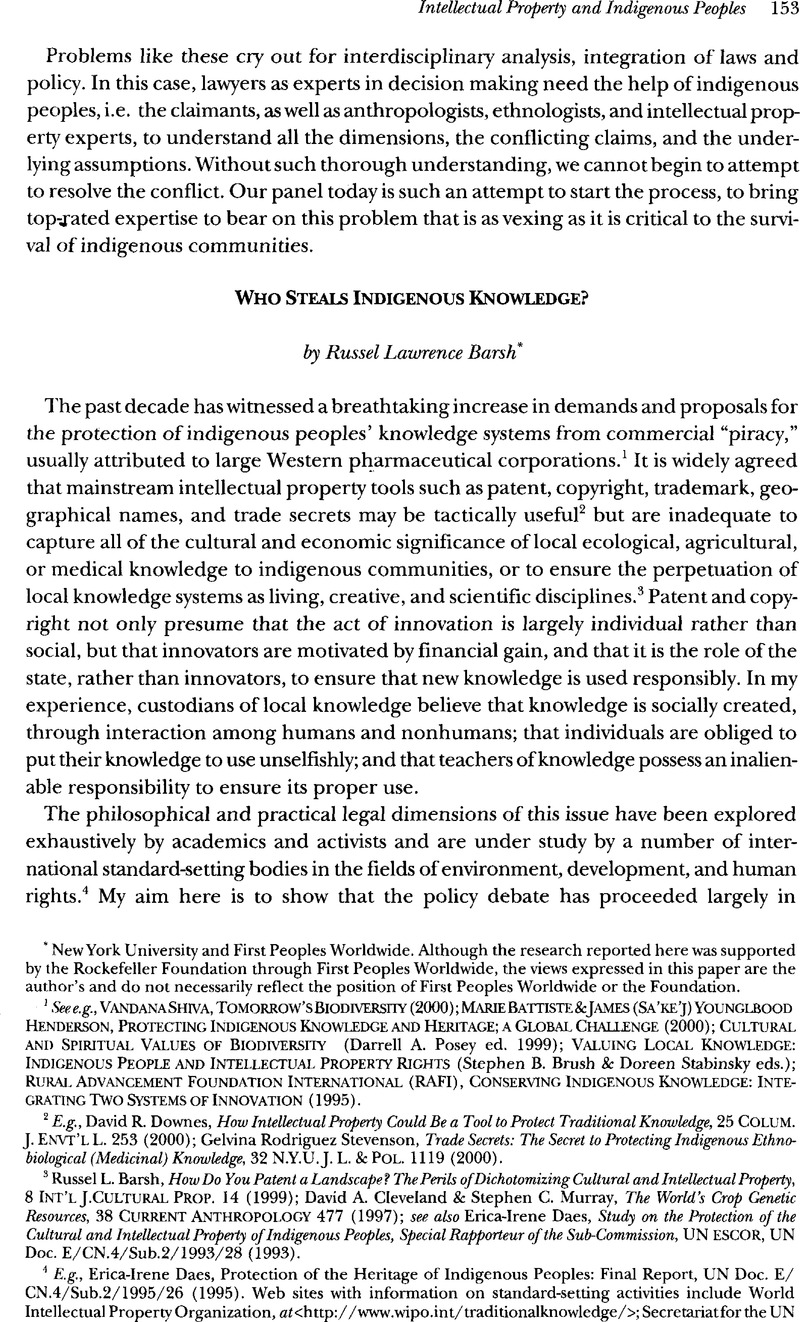Article contents
Who Steals Indigenous Knowledge?
Published online by Cambridge University Press: 28 February 2017
Abstract

- Type
- Intellectual Property and Indigenous Peoples
- Information
- Copyright
- Copyright © American Society of International Law 2001
References
1 See e.g., Vandana Shiva, Tomorrow’S Biodiversity (2000); Marie Battiste & James (Sa’ke’J) Younglbood Henderson, Protecting Indigenous Knowledge and Heritage; A Global Challenge (2000) ; Cultural and Spiritual Values of Biodiversity (Darrell A. Posey ed. 1999); Valuing Local Knowledge: Indigenous People and Intellectual Property Rights (Stephen B. Brush & Doreen Stabinsky eds.); Rural Advancement Foundation International (RAFI), Conserving Indigenous Knowledge: Integrating Two Systems of Innovation (1995).
2 E.g., Downes, David R., How Intellectual Property Could Be a Tool to Protect Traditional Knowledge, 25 Colum. J. Envt’l L. 253 (2000)Google Scholar; Stevenson, Gelvina Rodriguez, Trade Secrets: The Secret to Protecting Indigenous Ethnobiological (Medicinal) Knowledge, 32 N.Y.U.J. L. & Pol. 1119 (2000)Google Scholar.
3 Barsh, Russel L., How Do You Patent a Landscape? The Perils of Dichotomizing Cultural and Intellectual Property, 8 Int’l J. Cultural Prop. 14 (1999)Google Scholar; Cleveland, David A. & Murray, Stephen C, The World’s Crop Genetic Resources, 38 Current Anthropology 477 (1997)CrossRefGoogle Scholar; see also Daes, Erica-Irene, Study on the Protection of the Cultural and Intellectual Property of Indigenous Peoples, Special Rapporteur of the Sub-Commission, UN Escor, UN Doc. E/CN.4/Sub.2/1993/28 (1993)Google Scholar.
4 E.g., Erica-Irene Daes, Protection of the Heritage of Indigenous Peoples: Final Report, UN Doc. E/ CN.4/Sub.2/1995/26 (1995). Web sites with information on standard-setting activities include World Intellectual Property Organization, at <http://www.wipo.int/traditionalknowledge/>; Secretariatfor the UN Convention on Biological Diversity, and the State Parties’ Working Group on Traditional Knowledge and Management Practices, at <http://www.biodiv.org/doc/>; Food and Agriculture Organization, Commission on Genetic Resources, at <http://www.fao.org/ag/cgrfa>; United Nations Development Programme, at <http://www.undp.org/csopp/cso/NewFiles/ipindex.html> ; and World Bank Environment Division, at <http://www.worldbank.org/afr/ik/index.htm>.
5 The European folk category is biased by considerable recent interest in Aloe vera (eight patents, albeit five by a single company, Carrington Laboratories). Adjusting for this bias, only four different plants were the subject of patents.
6 Drug Discovery, Economic Development and Conservation: The International Cooperative Biodiversity Groups, 37 Pharmaceutical Biology (Joshua P. Rosenthal ed., Supp. 1999).
7 The companies were Bristol-Myers Squibb, Glaxo Wellcome (now part of GlaxoSmithKline), Pharmacia (through its Searle and Monsanto divisions), and Xenova Discovery (now part of Cubist Pharamceuticals). AstraZeneca, Merck, and Pfizer also engaged in bioprospecting in the 1990s, but not with NIH sponsorship.
8 U.S. Patent No. 5,591,770 (use of extracts of the Sarawak tree Calophyllum lanigerumm chemotherapy), which is being worked by a joint venture between university scientists and the government of Sarawak.
9 Rosenthal, supra note 6, at 17, 33, 71, 90, 133.
10 Drews, Jurgen, Drug Discovery: A Historical Perspective, 287 Science 1960 (2000)Google Scholar; Marshall, Sid, Zurich Biotech Meeting Focuses on HTS>, R & D Magazine (March 1999), at 41 Google Scholar; Bunk, Steve, Shamans vs. Synthetics, 14 The Scientist 8 (2000)Google Scholar.
11 Peltonen, Leena & McKusick, Victor A., Dissecting Human Disease in the Postgenomic Era, 291 Science 1224 (2001)Google Scholar Rosamond, John & Allsopp, Alieen, Hamessingthe Power of the Genome in the Search for New Antibiotics, 287 Science 1973 (2000)CrossRefGoogle Scholar.
12 Cox, Paul A., Will Tribal Knowledge Survive the Millennium ? 287 Science 44 (2000)CrossRefGoogle ScholarPubMed.
13 Barsh, Russel L., Traditional Healing: The Epistemology of Systems, 56 Hum. Org. 28 (1997)CrossRefGoogle Scholar.
14 “Folk” medicine is used here to distinguish the orally transmitted medical traditions of European cultures as well as literate non-European medical systems of China, Japan (Kampo), and India (Ayurvedic and Unanic) from the healing practices of indigenous and tribal peoples.
15 “North” is used here to refer to the industrialized countries of the European Community, United States, Canada, Australia, New Zealand, Japan, and Switzerland.
16 Armenia, Bolivia, Bulgaria, Chile, China, Colombia, Cuba, Egypt, Estonia, Iran, Israel, Jordan, Kenya, Lebanon, Madagascar, Malaysia, Mali, Mauritius, Morocco, Nepal, Pakistan, Palestine, Papua New Guinea, Paraguay, Philippines, Singapore, Sri Lanka, South Korea, Taiwan, Tanzania, Thailand, Togo, Trinidad & Tobago, Uganda, Yugoslavia, Zambia, Zimbabwe.
17 Hosted by the University of Georgia, Athens, Georgia (Oct. 22-28, 2000).
18 The only academic standards thus far adopted with specific reference to research on indigenous peoples’ knowledge are the Code of Ethics (1988) adopted by the International Society for Ethnobiology, available at <http://guallart.dac.uga.edu>.
19 Pharmaceutical Research and Manufacturers of America (PhRMA), Pharmaceutical Industry Profile 2000, available at <http://www.phrma.org/publications>.
20 Each corporation accordingly tends to focus on a few therapeutic fields. Chemotherapy dominates the product portfolios of Bristol-Myers Squibb and Pharmacia, for example, and GlaxoSmithKline’s pipeline. AztraZeneca’s strengths are hypertension management, asthma, and surgical anesthesia. Only Pfizer and Pharmacia developed treatments for erectile dysfunction, but Pfizer’s Viagra (sildenafil citrate) has become a “blockbuster” worth more than a billion dollars in annual sales.
21 See, e.g., Enserink, Martin, Malaria Researchers wait for Industry to join Fight, 287 Science 1956 (2000)CrossRefGoogle Scholar.
22 AstraZeneca, Bristol-Myers Squibb, GlaxoSmithKline, Merck, Pfizer Warner Lambert, and Pharmacia. AstraZeneca, GlaxoSmithKline and Pharmacia are headquartered in the European Community, the rest in the “technology corridor” of the Atlantic United States.
23 These categories include adjunctive care, e.g., drugs to protect the brain during chemotherapy, and in the case of infectious and contagious diseases, preventive as well as therapeutic agents.
24 Alzheimers, Parkinsons, menopause hormone replacement, osteoporosis.
25 Measles, mumps, rubella, chicken pox, diptheria, poliomyelitis.
26 Includes antivirale, birth control, glaucoma, obstructive lung diseases, growth anomalies.
27 Barsh, Russel L., Chronic Health Effects of Dietary Change on Hunter-Gatherers: Lessons from North American Indians andlnuit, 18 Medical .Anthropology 135 (1997)CrossRefGoogle Scholar.
28 Lori B. Andrews & Dorothy Nelkin, Body Bazaar; The Market For Human Tissue in the Biotechnology Age (2001).
- 2
- Cited by


